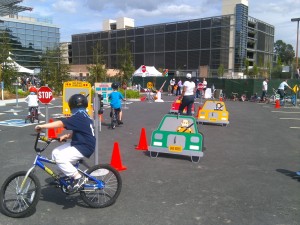A Rodeo for Bikes?
A rodeo without bulls, clowns, and (most likely) country music? That’s absolutely correct. The Utah Department of Public Safety has determined that such events can be a fun and educational way to inform cyclists about bike safety at a young age. The official mission statement of the Bike Rodeo Program in Utah states:
A bicycle rodeo is a clinic that teaches children the importance of riding a bicycle safely and what skills and precautions they need to develop to have a safe time on their bicycles.
These bike rodeos are designed for children aged 4 to 13 years. The Rodeo Program is thought to be brand new and even foreign to some parents who did not experience the same training when they were children. The Utah Department of Public Safety believes, however, that it is crucial for children to learn not only how to properly ride a bike, but also to become familiar with traffic laws.
With an increasing number of cyclists as filling up the roads in Utah, it is becoming ever more important to take all safety precautions. Children on a bicycle are especially vulnerable, but are much safer when equipped with knowledge about traffic laws. A full listing of the Utah Cycling Laws can be found here.
What training coincides with a bicycle rodeo?
Each rodeo usually begins with a short lecture on bicycle safety and a safety inspection for both the rider and the bicycle. In addition to simple safety checks, the children are taught the acronym ABC (Air, Brakes, Chain) so that they can be responsible for the maintenance of their bikes in the future. The importance of bike helmets is strictly emphasized and enforced. A full demonstration of helmets’ effectiveness can be found here.
Bicycle rodeos also have a road course to teach children how to handle riding their bikes in real life situations, such as traffic lights, stop signs, pedestrians crossing the streets, and road intersections. Hand signals and traffic laws are demonstrated, and the children get to experience cycling interactions immediately after.
These road courses act as a type of obstacle course which the children can navigate on their bicycles in a safe, secure environment. Some markers focus on quick turns and emergency braking—vital skills for young cyclists. To add fun and intrigue, a “Slow Race” takes place at the end of the course which helps the children to focus on balance.
Getting involved in your community
To the benefit of children in neighborhoods throughout Utah, the Bike Rodeo Program is available in conjunction with the Utah Emergency Medical Services for Children. Also, the Highway Safety Office has two bicycle rodeo trailers that contain all the necessary equipment for conducting a bicycle rodeo. These trailers can be used by the public free of charge. To reserve the bicycle rodeo trailer, or for more information on conducting a bicycle rodeo, contact Keri Gibson at 801-243-7571 or kgibson@utah.gov.
The bike rodeo can also be used as a great afternoon scouting activity for boys and girls. Cub Scouts can do this as a great way to heighten community involvement and spread the word about scouting in the area. It can be fun for scouts and non-scouts alike. The day starts with checking in and registering bicycles, going to a bicycle safety clinic, eating refreshments, checking out Cub Scout pack exhibits, and learning how to sign up for Cub Scouting. The main purpose of this event is to attract and recruit more families into the scouting world. All the required materials and information can be found at the Utah Scouting Website.
Christensen and Hymas advocates increased safety for the well-being of cyclists within the state of Utah. Cyclists, especially the young ones, should be given all the support and information that they need to ride safely. If you or someone you know has been involved in a cycling accident and experienced injuries, call us at (801)506-0800 for a free consultation. You deserve to be compensated for the injuries, loss of income, and pain and suffering that you have received from another’s negligence.
Image courtesy of www.ebbc.org

